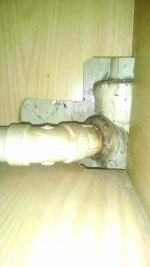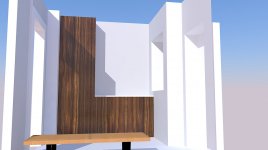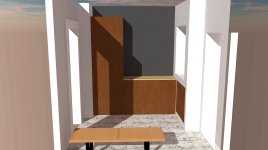I'm nearly wrapped up with my kitchen (I'm just waiting for a nice weekend to finish the baseboards and put a coat of finish on the new flooring) and have started removing the cabinets from the old kitchen. At this point, the goal is to get it done within a reasonable cost and time frame, as I'm hoping to move in the next year or so.
The plan is, basically, to turn the room into something like a pantry room/mud room. I figure since there is an existing supply and DWV, I'll put a small bar sink in there for washing up after coming in from outside.
So here are the questions I'm trying to answer before I get started buying things:
1) Before I completely take out the existing sink and base cabinet, I wanted to make sure I understood what I'm looking at here. I'm really bad at plumbing. How this pvc pipe is tying into the cast iron dwv pipe?
View attachment 1
It looks like the coupling is some kind of screw-on but I can't really tell. The dwv pipe is buried in the corner so I am basically reaching in there with my phone and trying to get a better view by taking a photo.
2) The room is small (about 68 sq feet) and I plan on putting in some shallower cabinets on one side, and leaving the other side open, with possibly a bench or something. The existing walls aren't in great shape. Where the upper cabinets were, there is some damage to the plaster and also some torn up wallpaper. Where the cabinets were not, there are 2-3 layers of wallpaper with at least 4 layers of paint that I can count. The house was built in 1930, so lead is another possibility. I hate removing wallpaper, but i think skimming over it is probably asking for a lot of trouble. The walls are plaster over brick. Does it make sense to put up some hat channel or furring strips and just add some drywall?
3) The floor is two layers of asbestos tiles (confirmed through testing). I'm thinking the floating an LVT floor over this is the simplest solution and avoids adding a lot of extra expenses. Any particular LVT floor that is good? Any that I should avoid? I'm hoping to avoid the fake-wood look.
Here's some images of what my intended design might look like:
View attachment 2
View attachment 3
View attachment 4
Anything else I should take into consideration before I get committed?
Thanks,
Adam
The plan is, basically, to turn the room into something like a pantry room/mud room. I figure since there is an existing supply and DWV, I'll put a small bar sink in there for washing up after coming in from outside.
So here are the questions I'm trying to answer before I get started buying things:
1) Before I completely take out the existing sink and base cabinet, I wanted to make sure I understood what I'm looking at here. I'm really bad at plumbing. How this pvc pipe is tying into the cast iron dwv pipe?
View attachment 1
It looks like the coupling is some kind of screw-on but I can't really tell. The dwv pipe is buried in the corner so I am basically reaching in there with my phone and trying to get a better view by taking a photo.
2) The room is small (about 68 sq feet) and I plan on putting in some shallower cabinets on one side, and leaving the other side open, with possibly a bench or something. The existing walls aren't in great shape. Where the upper cabinets were, there is some damage to the plaster and also some torn up wallpaper. Where the cabinets were not, there are 2-3 layers of wallpaper with at least 4 layers of paint that I can count. The house was built in 1930, so lead is another possibility. I hate removing wallpaper, but i think skimming over it is probably asking for a lot of trouble. The walls are plaster over brick. Does it make sense to put up some hat channel or furring strips and just add some drywall?
3) The floor is two layers of asbestos tiles (confirmed through testing). I'm thinking the floating an LVT floor over this is the simplest solution and avoids adding a lot of extra expenses. Any particular LVT floor that is good? Any that I should avoid? I'm hoping to avoid the fake-wood look.
Here's some images of what my intended design might look like:
View attachment 2
View attachment 3
View attachment 4
Anything else I should take into consideration before I get committed?
Thanks,
Adam




